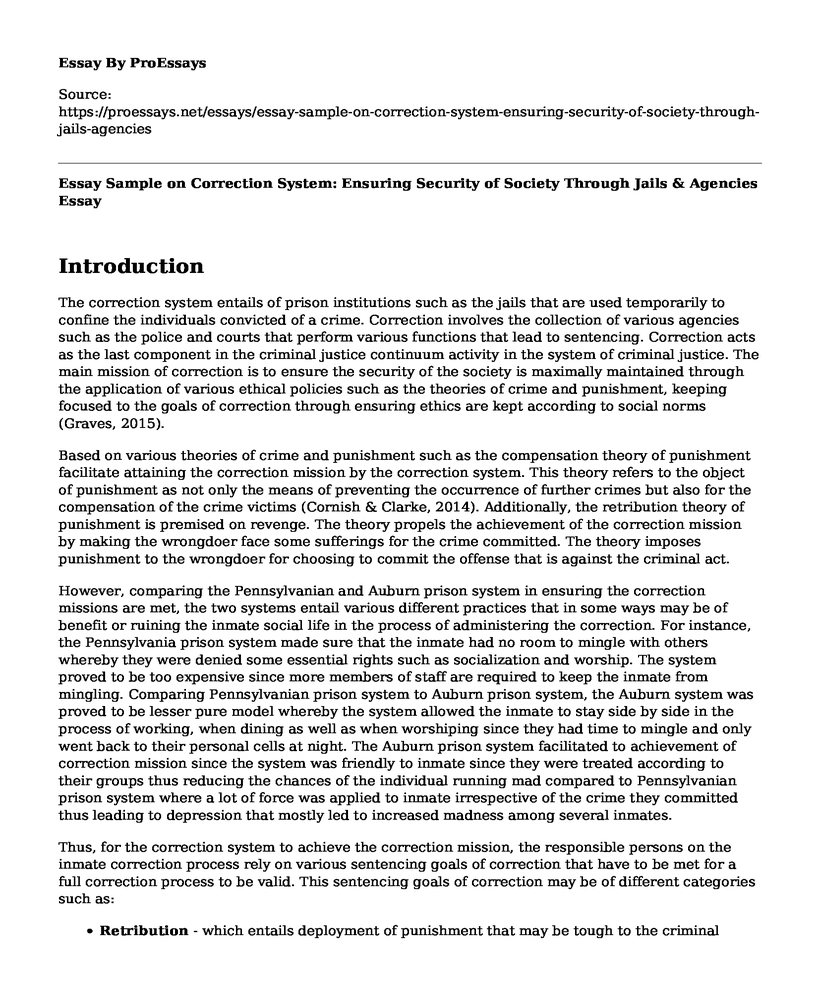Introduction
The correction system entails of prison institutions such as the jails that are used temporarily to confine the individuals convicted of a crime. Correction involves the collection of various agencies such as the police and courts that perform various functions that lead to sentencing. Correction acts as the last component in the criminal justice continuum activity in the system of criminal justice. The main mission of correction is to ensure the security of the society is maximally maintained through the application of various ethical policies such as the theories of crime and punishment, keeping focused to the goals of correction through ensuring ethics are kept according to social norms (Graves, 2015).
Based on various theories of crime and punishment such as the compensation theory of punishment facilitate attaining the correction mission by the correction system. This theory refers to the object of punishment as not only the means of preventing the occurrence of further crimes but also for the compensation of the crime victims (Cornish & Clarke, 2014). Additionally, the retribution theory of punishment is premised on revenge. The theory propels the achievement of the correction mission by making the wrongdoer face some sufferings for the crime committed. The theory imposes punishment to the wrongdoer for choosing to commit the offense that is against the criminal act.
However, comparing the Pennsylvanian and Auburn prison system in ensuring the correction missions are met, the two systems entail various different practices that in some ways may be of benefit or ruining the inmate social life in the process of administering the correction. For instance, the Pennsylvania prison system made sure that the inmate had no room to mingle with others whereby they were denied some essential rights such as socialization and worship. The system proved to be too expensive since more members of staff are required to keep the inmate from mingling. Comparing Pennsylvanian prison system to Auburn prison system, the Auburn system was proved to be lesser pure model whereby the system allowed the inmate to stay side by side in the process of working, when dining as well as when worshiping since they had time to mingle and only went back to their personal cells at night. The Auburn prison system facilitated to achievement of correction mission since the system was friendly to inmate since they were treated according to their groups thus reducing the chances of the individual running mad compared to Pennsylvanian prison system where a lot of force was applied to inmate irrespective of the crime they committed thus leading to depression that mostly led to increased madness among several inmates.
Thus, for the correction system to achieve the correction mission, the responsible persons on the inmate correction process rely on various sentencing goals of correction that have to be met for a full correction process to be valid. This sentencing goals of correction may be of different categories such as:
- Retribution - which entails deployment of punishment that may be tough to the criminal
- Deterrence - Which involves a punishment to notify the public on the consequences of committing a crime
- Incapacitation - a goal of correction that is meant to protect the society through keeping its civilized
- Restriction - Forms a correction goal that aims at making sure the criminal whole to his normal status such as ordering the payment of damages.
However, despite the much effort applied by the correctional worker to attain the correction mission, the prison system faces various ethical challenges that may slow the performance of the officers. For instance, the degree of brutality among some inmate towards the officers have been experienced in various part of the globe. Also, issues of corruption whereby some officers smuggle the prohibited items such as drugs in prison have been proved to be a major challenge by the prison system in meeting their correction mission. Additionally, unequal treatment of the inmate by the officers whereby some inmate are more likable has led to the eruption of violence in the correction centers thus lowering the process of attaining the correction mission
Conclusion
Based on the essay, for the correction system to achieve its mission, the expressed various mechanism have to be deployed uniformly towards the inmate. However, despite the effort that may be applied by the correctional officers, some ethical challenges that may be originating from either the inmate or the officers may form some barriers in achieving the correction mission.
References
Cornish, D. B., & Clarke, R. V. (Eds.). (2014). The reasoning criminal: Rational choice perspectives on offending. Transaction Publishers.
Graves, S. M. (2015). Correctional mission statements as indicators of the criminal justice policy environment: A research note. Criminal Justice Policy Review, 26(5), 488-499.
Cite this page
Essay Sample on Correction System: Ensuring Security of Society Through Jails & Agencies. (2023, Apr 08). Retrieved from https://proessays.net/essays/essay-sample-on-correction-system-ensuring-security-of-society-through-jails-agencies
If you are the original author of this essay and no longer wish to have it published on the ProEssays website, please click below to request its removal:
- The Impact of the Mental Capacity Act of 2005
- United Nations and Positive Human Rights Essay
- Essay Example on Blockchain in Healthcare: Unlocking Privacy & Security
- Essay on Diverting Domestic Violence Misdemeanors in Florida Prisons & Road Camps
- Essay Example on Antitrust Law: Efficiency or Justice?
- Case Study Sample on Mr. Moore Arrested & Charged Despite No Grounds: Conviction Reversed
- Gideon v. Wainwright: Right to Representation in Capital Offenses - Free Paper Example







